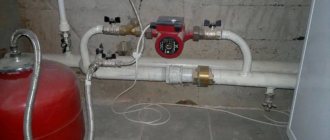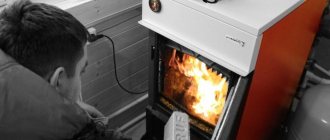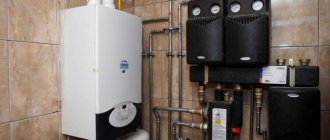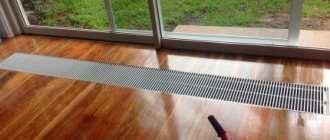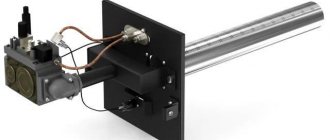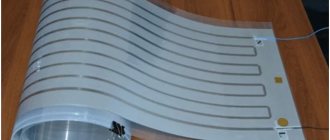An autonomous heating system for a private home is one of the most important factors influencing its improvement. But the correct distribution of warm air in residential premises depends not only on the comfort of living.
The heating system also performs protective functions, preventing the occurrence of dampness, mold and fungal attack. Since the cost of such systems is constantly growing, we will consider which types of heating are most relevant.
We asked specialists from the company AquaHit, which specializes in the installation of heating and water supply systems, to talk about this current type of heating.
Heating system with radiators and heated floors Source domostrou.by
Heating systems – requirements and choice
In modern construction, various types of heating systems and many model diagrams of related equipment are used. It is impossible to call one or another solution optimal, since when installing and choosing them, it is necessary to take into account specific conditions and a variety of initial data. However, there are several rules that any heating communications are subject to.
- The heating system in the house must ensure proper temperature regulation. In addition, heat must be efficiently transferred and distributed throughout all heated rooms. The heating system for a private home must meet several criteria, the main ones being:
- High efficiency at minimal cost. According to this indicator, the heating system must produce the required amount of heat for high-quality heating of the premises. At the same time, the costs of its installation and operation must be minimized.
- High degree of automation. In this regard, communications to ensure home heating should be used with minimal human intervention. This maximizes their safety.
Modern heating system with multiple heat sources Source homemarket.ua
- High reliability and wear resistance of all system components. Equipment purchased for installation of communications must be as reliable as possible with a long service life and a warranty from the manufacturer.
Quite often, when installing heating mains, the principle is applied - the simpler, the more reliable.
Connecting radiators
The choice of method for connecting them depends on their total number, installation method, length of pipelines, etc. The most common methods are:
• diagonal
(cross) method: the straight pipe is connected to the side of the battery at the top, and the return pipe is connected to its opposite side at the bottom; this method allows the heat carrier to be distributed across all sections as evenly as possible with minimal heat loss; used with a significant number of sections;
• one-sided:
also used with a large number of sections, the hot water pipe (straight pipe) and the return are connected on one side, allowing for sufficient uniform heating of the radiator;
• saddle:
if the pipes go under the floor, it is most convenient to attach the pipes to the lower pipes of the battery; due to the minimal number of visible pipelines, it looks attractive in appearance, but the radiators heat unevenly;
• lower:
the method is similar to the previous one, the only difference is that the direct pipe and the return pipe are located almost at the same point.
Methods for connecting radiators
To protect against the penetration of cold and create a thermal curtain, the batteries are located under the windows. In this case, the distance to the floor should be 10 cm, from the wall - 3-5 cm.
Types of autonomous heating systems
It is worth immediately noting that it is better to entrust the installation of heating systems to professionals. All heating systems are, first of all, classified according to the type of fuel that is used to heat the coolant. If for some reason the optimal type of fuel changes frequently in your area, then you may want to consider combination boilers, which allow you to use multiple types of fuel or energy sources.
A striking example is solid fuel boilers with the ability to connect gas or electricity. There are models on the market that combine several methods of increasing the temperature of the coolant - gas, electricity, solid or liquid fuel.
Such boilers are endowed with all the advantages of standard devices operating on one type of fuel. However, they increase many times over, since several types are combined in one device. Now let's look at the types of heating systems in more detail.
Water heating system with a modern radiator Source www.remontnik.ru
Water heating
This type is the most common. The relative ease of installation and availability of the coolant - water, will retain the relevance of water heating for many years to come. To ensure optimal heating, various installation schemes are used. This can be a two-pipe heating system or a single-pipe heating system.
Radiators made of cast iron, steel or aluminum act as heat exchangers in such systems. Also, bimetallic equipment or converter-type batteries are popular. The pipeline is made of metal or special plastic. Such a system can be built on the basis of almost any heating boiler.
Advantages:
- the ability to control the temperature of system components;
- the possibility of installing a pipeline of a smaller cross-section relative to a steam and air heating system;
- high degree of safety during operation;
- fairly low financial costs and minimal requirements for the quantity of consumables;
- no noise during operation;
- uniform heating of all components included in the system.
"Leningrad heating" wiring Source aquasistem.ru
Disadvantages:
- the likelihood of clogging the system with air locks;
- the need for constant monitoring for the performance of the thermal energy source;
- when using metal communications, there is a high probability of corrosion;
- when using old-style radiators, the system warms up slowly;
- difficulties during installation work;
- sensitivity to low ambient temperatures with the risk of system defrosting.
Air heating
In such systems, the room is heated by air flow. Ambient air is taken in by intakes and supplied to the heating element of the system. It can be gas or electric equipment. A water heat exchanger can also be used.
The heated air is forced into the room by means of a fan. When a new portion is taken in, already heated air from the rooms is mixed with fresh air from the street. To do this, it is advisable to install a filter element in the system that will trap dust and other unwanted fractions.
The process is performed cyclically until the room temperature is raised to the required level. The thermostat installed in the system switches off at the desired level and turns on the equipment when it deviates minus one degree.
House air heating diagram Source build-experts.ru
Air heating systems offer high flexibility for the installation of various modules and add-ons. If you install a water cooler or an evaporator from an air conditioner in a channel with a heater, then in the summer you can use communications to create coolness in the room.
If there is a heat pump function in the air conditioner evaporator, in winter this circuit is also used as a heating element. The air supply channel itself can be equipped with a humidifier, sterilizer, ionizer and many other additional devices.
Advantages:
- the ability to install all types of air treatment at “one point”, from filtration to humidification.
- additional operating mode options – air conditioning or heat pump;
- due to controlled ventilation, up to 30% of energy resources are saved in relation to other types of heating;
- excellent comfortable characteristics combining heating, ventilation and air filtration as standard equipment;
- temperature control using a thermostat can be done via the Internet;
- the system is not afraid of low temperatures, has high reliability and a long service life;
- ease of use, since all elements of the system are easily accessible and can be quickly replaced.
Air heating using a fireplace Source stroikairemont.com
Disadvantages:
- most of the work on installing the system should be planned at the building design stage;
- air communications require a certain space in the internal volume of the room.
What material are boiler heat exchangers made of?
Once you have decided on the type of fuel and type of boiler, you need to pay attention to the design features and operational characteristics.
An important parameter is the type of material from which the heat exchanger is made. There are only two basic and widespread options :
- cast iron;
- steel.
Cast iron heat exchangers are more durable, their useful life is more than twenty years, and they are resistant to corrosion. But this material is quite sensitive to mechanical stress and temperature changes, which can lead to deformation of the structure. Cast iron boilers consist of modules and sections, which facilitates transportation and installation.
This is an excellent solution for solid fuel wood boilers. But this is not a very good solution for automatic solid fuel boilers, since these boilers operate in start-stop mode, which leads to frequent temperature changes, and this adversely affects cast iron. In addition, a cast iron heat exchanger requires frequent cleaning, and it is not very convenient to clean, unlike a steel one.
Steel heat exchangers are more resistant to temperature changes and mechanical damage, but their useful life is slightly shorter.
This solution is perfect for appliances operating on hard and brown coal. Steel boilers are welded from fragments of sheet steel; this is a non-demountable structure.
Much less common materials for heat exchangers are copper, ceramic-coated steel, or combined solutions.
Video description
Watch the video to see what air heating is in a house:
Steam heating
This closed heating system remains a fairly popular solution in our time. Various types of fuel are well suited for its operation - solid, gas and electricity. Combined temperature sources are also used, which are given priority during installation work. Proper selection of a steam boiler helps to significantly save on living space heating costs.
The principle of operation of such a system is to bring water to the boiling point. The resulting steam is sent to the heating system. Passing through the communications, it cools and flows back into the steam boiler in the form of condensate. How reliable the system will be during operation directly depends on the model of the steam boiler. It is selected based on the structural features of the heated building and its area.
Advantages:
- quickly achieving the required temperature in the building, regardless of its area;
- low probability of failure at low ambient temperatures;
- cyclical heating process;
- environmental safety of the system.
Boiler for steam heating Source build-experts.ru
See also: Catalog of projects of two-story houses with a boiler room and fireplace
Flaws:
- explosion hazard of the steam boiler and the need for constant monitoring during operation;
- high complexity of installation work;
- high price of components;
- for commissioning it is necessary to obtain permission from the regulatory authorities;
- a fairly high noise level when filling the system with steam;
- negative impact on the operational capabilities of the high coolant temperature system;
- there is no possibility to fully control the temperature conditions indoors.
Gas heating
In areas with main gas communications, natural gas heating is installed. Essentially, this is a type of water heating. It’s just that in this case gas acts as the main source of energy. However, both air and steam systems can be implemented on this basis.
In the absence of main gas lines, you can organize a small gas storage facility, which needs to be filled with liquefied gas for the heating season. Such storage facilities are called gas tanks and gas is delivered and stored in liquefied form.
Floor-standing gas boiler Source www.ural.org
Advantages:
- long service life of the system equipment;
- high level of fuel economy;
- ecological purity of the energy source.
Flaws:
- high complexity of installation work;
- high cost of system components;
- the need to obtain permission from regulatory authorities;
- the need for constant monitoring by service departments;
- in the absence of a main connection, additional costs for the necessary equipment;
- In the absence of main gas lines, using liquefied gas in a gas tank will cost more than natural gas, plus you will have to regularly spend time refueling the system.
Electric heating
The three main advantages of electric heating systems are the possibility of full automation, safety and environmental friendliness. There is only one minus – the cost of electricity is still quite high. But if the financial issue is not in the foreground, then convenience outweighs the cost of the issue.
Most electric heating systems do not require the use of coolants. In convectors, infrared heaters, electric fireplaces and similar devices, electricity is directly converted into heat. The only exception is electric boilers that heat water for the heating system and/or domestic use.
Wall-mounted electric boiler Source avatars.mds.yandex.net
Advantages:
- fairly affordable prices for system components;
- the use of electric boilers in hot water supply systems simultaneously with heating of premises;
- mobility of many system components;
- no need for maintenance with serious financial costs;
- ample opportunities for automating the process and maintaining optimal temperature conditions in the building;
- environmental safety of the heat source.
Flaws:
- High cost of electricity.
- The heating system requires fairly high power to operate. However, even the standard 10-15 kW is usually more than enough to heat a house of 100-150 m².
- If there are frequent interruptions in the power supply “on the line”, then it is necessary to provide for the presence of an uninterruptible power supply and/or a generator. However, the same applies to other heating systems, because for the operation of automation and pumps they require an uninterrupted power supply.
Option one - classic boilers
The first option is traditional, classic, which has been used for thousands of years in conventional stoves, put in firewood or coal, and adjusted the air supply with a damper. The main disadvantages are the need for constant supervision and low efficiency, the inability to accurately regulate the combustion process. Advantages - the simplest boiler in technical terms and maintenance, operating on almost any type of solid fuel.
Examples of classic boilers:
- ZOTA Carbon
with a steel heat exchanger, operating on coal with a fraction of
10.00 - 50.00 mm
, power
from 15.00 to 60.00 kW
, with top fuel loading, a movable grate and a design that ensures maximum afterburning of fuel and precise oxygen supply to firebox; - Buderus Logano
with a steel heat exchanger, can work either separately or in combination with a gas or liquid fuel boiler with a capacity of
12, 16, 20, 24, 27, 32, 45 kW
, in systems with natural and forced circulation of coolant, is small in size and heat exchanger protection, large volume of ash pan and loading chamber, works on wood (logs up to 33.00 and 53.00 cm long), coal, coke.
The burning time of such boilers is 3-7 hours.
Video description
Watch the video to see all the pitfalls when installing heating in a private home:
See also: Catalog of companies that specialize in electrical and heating.
Geothermal heating
When choosing energy resources provided by the earth as a heat source, this means obtaining an environmentally friendly and economical home heating system. Along with gas heating, one of the energy sources is geothermal heat from the earth. The soil absorbs about 98% of all energy coming from the sun. There is always heat in the deep layers and this does not depend on the time of year and temperature on the surface.
The geothermal heating system consists of two circuits - external and internal. External communications are responsible for switching between the heat exchanger and the internal circuit of the system. They are deep underground.
Geothermal heating scheme Source respect-stroy.com
The internal circuit is a classic one-pipe system or a two-pipe heating system for a private house with radiators. The coolant in them is either water or another suitable liquid, for example, special oil.
Advantages
- minimal dependence of the system on climatic conditions;
- low costs for operating the system;
- stable flow of thermal energy in the required quantity;
- environmental safety of the heat source.
Flaws:
- high complexity of installation work;
- high cost of system components;
- low payback of the system - about 8 years;
- it is necessary to construct a collector.
Wiring with polypropylene
In the age of new technologies, new materials are increasingly being used in construction, displacing traditional ones. Just a few decades ago, it was difficult to imagine that drainpipes could be made of anything other than metal. Today, water pipes are made exclusively from polymer.
The advantages of polypropylene pipes are:
- low price;
- simple installation diagram;
- high service life;
- light weight of materials.
The disadvantage, but not significant, is the lack of bends on the pipes. To do this, you have to use special connecting elements: tees, angles, couplings, etc. About the disadvantages of polypropylene, watch the video below:
To fasten polypropylene pipes with another material (metal), so-called fittings are used. They themselves are made of polypropylene, but have metal threads inside.
Installation methods
Let's touch on methods for installing heat-carrying communications. There is no clear opinion on this issue, so it is better to contact a company that installs heating systems for advice. The most common installation options are a single-pipe or two-pipe heating communications system. We will not dwell on them, but will tell you about two lesser-known methods.
Collector system
The main unit with this installation method in this system is the collector, which is responsible for the distribution of the coolant.
Manifold for a single-pipe heating system Source termoresurs.ru
Legend
There are special programs that help you correctly design the heating system of your home. Each has its own symbols. They serve to ensure that everyone can understand the drawing.
And accordingly, for the general accessibility and ease of reading of the map of the heating system, each component is indicated by a specific letter marking:
- “P” – supply systems, exhaust systems, system installations;
- “B” – system installations;
- “U” – air curtains;
- “A” – heating units.
These designations will be used for heating system elements.
To calculate a forced heating system, the following symbols will be used:
- “ST” – OS water riser;
- “GST” – the main water riser of the OS;
- “GV” – horizontal branch;
- “K” – compensator.
We will call the heating system as a whole “OS”.
The diagrams present us with a heating system with the above markings. On the plan the operating systems are depicted as dots.
Their diameter is about 2 mm. Heating systems in section, its drawings or diagrams are reproduced on the following scales:
- Ventilation and heating installations Layout diagram, plan – 1 to 400, 1 to 800
- Sections and plans – 1 to 50, 1 to 100;
- Sections and plans – 1 to 100, 1 to 200
Schematic diagram of heating
When designing the above data in detail, scales are used - 1 to 2, 1 to 5, 1 to 10. OSs are not designed separately. More precisely, a separate image of them is not found. Most often, one drawing or diagram combines an image of the heating system, ventilation system and air conditioning system in the room.
Video description
This video will show you how to make a manifold for a heated floor with your own hands:
A collector heating system, also known as a radiant heating system, consists of the following elements:
- collector;
- pump;
- heating devices;
- safety devices;
- expansion tank;
- pipeline;
In turn, the collector assembly is mounted in two parts:
- Input - it is connected to the heating unit, receiving the coolant at the required temperature, and distributes it along the circuits of the system.
- Output - return circuits are connected to it, which release the cooled coolant, which is redirected to the boiler for the next heating.
The main difference and advantage of this installation method is the ability to independently connect heating devices to the system. This allows you to simplify repair work and more accurately regulate the temperature in the room. The disadvantage is the high costs of communication and installation.
Leningradka system
Another interesting solution is the Leningrad heating system. The Leningradka heating system in a private house allows you to level out heat loss by the coolant when moving away from the boiler.
This is the main problem of classical type heating systems - achieving the same temperature along the entire length of the line. To solve this problem, it is necessary to increase the number of heating devices as they move away from the heat source.
Radiator installed according to the “Leningradka” scheme Source plusteplo.ru
Non-specialized information
A schematic diagram of a heating system is usually understood as a simple diagram that shows the main elements of water heating combined into a single system.
The latter can be implemented using several methods, but in any case it includes the following elements:
- Heating boiler - supplies heating fluid.
- A circulation pump or accelerating tank (depending on the type of system) - supplies the movement of coolant along the circuit.
- Expansion tank - compensates for thermal expansion of the coolant and water hammer.
- Circuit - imagines a closed path along which the coolant enters the radiators and then returns to the boiler.
- Heating radiators are devices that provide heating to a room.
- Coolant is a liquid that takes heat from the boiler and transfers it to the radiators. Much more often, plain water or antifreeze is used for these purposes. The latter has a lower freezing point.
The differences between the schemes are as follows:
- In the method of ensuring coolant circulation,
- In the method of connecting radiators.
Below we will look at the highlights of each of them.
Differences in Sealing
All heating systems are divided into two types - open and closed heating systems, the difference is that open communications communicate with the atmosphere, while closed ones do not.
Open systems
An open heating system has a leaky expansion tank. A drain pipe is installed in it, which drains excess water into the sewer or outside the building. The shape of the vessel does not matter in this case. The tank is located at the highest point of thermal communications.
Scheme of an open type heating system Source avatars.mds.yandex.net
Since the tank has an easy-to-open lid, the system can be filled with water manually using buckets or a hose. The pressure in the circuits is always equal to atmospheric pressure and for this reason such systems do not require the installation of monitoring devices and are safer during operation.
Closed systems
A closed-type heating system with a pump and expansion tank is more complex to install. The elements included in the composition are completely sealed and the shape of the tank is important; it is selected in such a way as to withstand pressure with a minimum wall thickness.
Such systems require more careful attention because they contain high pressure. To ensure safety during operation, it is necessary to install control devices and an emergency valve on the expansion tank.
Closed heating system with forced circulation Source dpa.cv.ua
